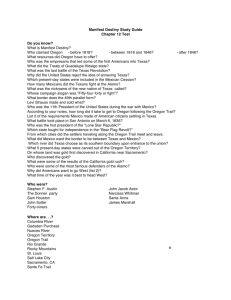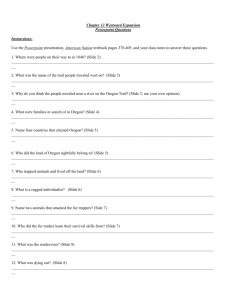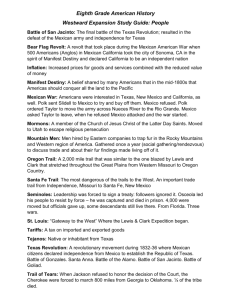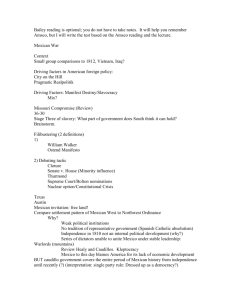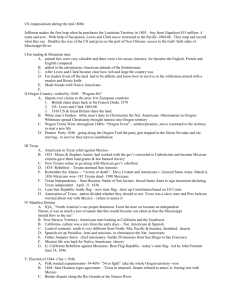Manifest Destiny
advertisement
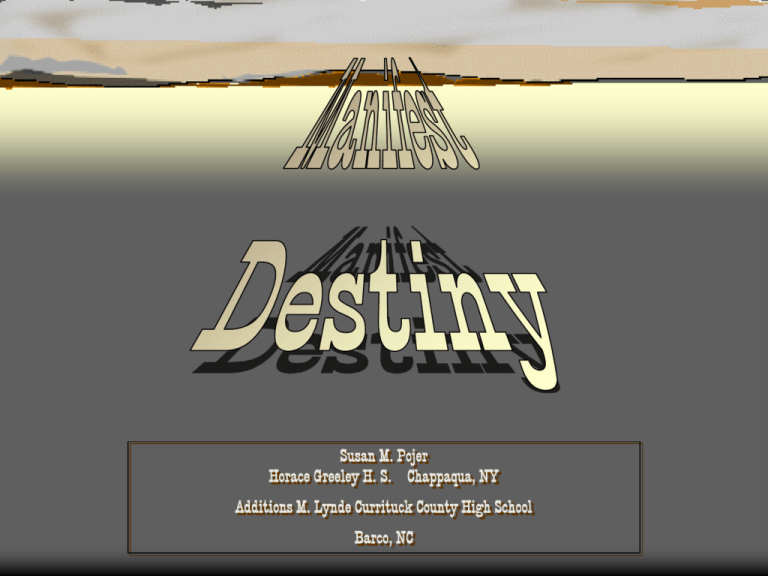
Susan M. Pojer Horace Greeley H. S. Chappaqua, NY Additions M. Lynde Currituck County High School Barco, NC Trends in Antebellum America: 1810-1860 1. New intellectual and religious movements. 2. Social reforms. 3. Beginnings of the Industrial Revolution in America. 4. Re-emergence of a second party system and more political democratization. 5. Increase in federal power Marshall Ct. decisions. 6. Increase in American nationalism. 7. Further westward expansion. “Manifest Destiny” First coined by newspaper editor, John O’Sullivan in 1845. ".... the right of our manifest destiny to over spread and to possess the whole of the continent which Providence has given us for the development of the great experiment of liberty and federative development of self-government entrusted to us. It is right such as that of the tree to the space of air and the earth suitable for the full expansion of its principle and destiny of growth." A myth of the West as a land of romance and adventure emerged. “American Progress” by John Gast, 1872 The Pony Express Between April, 1860 and Nov., 1861. Delivered news and mail between St. Louis, MO and San Francisco, CA. Took 10 days. Replaced by the completion of the trans-continental telegraph line. Aroostook “War,” 1839 The only war ever declared by a state. Between the Canadian region of New Brunswick and the state of Maine. Cause: The expulsion of Canadian lumberjacks in the disputed area of Aroostook by Maine officials. Congress called up 50,000 men and voted for $10,000,000 to pay for the “war.” General Winfield Scott arranged a truce, and a border commission was convened to resolve the issue. Maine Boundary Settlement, 1842 Expansion in Texas 9.3 • GTT - Gone to Texas Why? Land(Real estate deal- original 300) Mexicans asked for settlers (Tejanos) Needed to become Catholic Known as "The Father of Texas," Stephen F. Austin established the first AngloAmerican colony in the Tejas province of Mexico and saw it grow into an independent republic. His father, Moses Austin, received approval to settle 300 American families on 200,000 acres; he died before he could accomplish this, but his son, Stephen, did it for him. Stephen F. Austin (1793-1836) Key Figures in Texas Independence, 1836 Sam Houston (1793-1863) Steven Austin (1793-1836) Sam Houston took control of the Texas forces after the fall of the Alamo and Goliad, and conducted the retreat of the army to the site of the Battle of San Jacinto April 21, 1836, defeated Santa Anna and secured Texas longsought independence. elected the first President of the Republic of Texas After statehood in 1845, Houston was elected Senator from Texas to the Congress of the United States. Still later, in 1859, Houston was elected to serve as Governor of the State of Texas Antonio López de Santa Anna (1794-1876) Davy Crockett "You may all go to hell, and I will go to Texas." --David Crockett to former constituents, 1835 With his death at the Alamo, a willing sacrifice to Texas’ freedom, Crockett became a mythic figure Crockett is the quintessential frontiersman, the inspiration for the American image of the “hunter-hero,” a symbol of the “Age of Common Man,” a martyr for the cause of America's Manifest Destiny and a celebrity of popular culture Texas Declaration of Independence The Republic of Texas Remember the Alamo! Battle of the Alamo Jim Bowie at the Alamo Davey Crockett’s Last Stand The Battle of the Alamo General Antonio Lopez de Santa Anna Recaptures the Alamo Meanwhile….. Despite the win, the 13-day holdout stalled the Mexican Army's progress and allowed Sam Houston to gather troops and supplies for his later success at the Battle of San Jacinto. The Texian revolutionaries went on to win the war for their independence. The Year is 1836 and in the rest of the country…. Overland Immigration to the West Between 1840 and 1860, more than 250,000 people made the trek westward. Trails Westward The Oregon Trail – Albert Bierstadt, 1869 THE OREGON TRAIL During the 1840s the federal government offered land grants to settlers, such as these pioneers, who would make the journey to Oregon. Nearly 900 people followed the Oregon Trail in 1843 and settled in the territory. During the 1840s the federal government offered land grants to settlers, such as these pioneers, who would make the journey to Oregon. Nearly 900 people followed the Oregon Trail in 1843 and settled in the territory. The Oregon Trail, as it wandered across our valley and what is now Malheur County, was not a narrow wagon rut. Taking many different paths, the wagon trains wandered across the valley created by the confluence of the Boise, Owyhee, Payette, Malheur, Weiser and Snake Rivers. The early pioneers were not impressed with the Snake River Valley. "The plains smoked with dust and death," remarked Thomas Farnham in 1839. "This is barren, God-forsken country, fit for nothing but to receive the footprints of the savage and his universal associate, the coyote." Most people moving west traveled in covered wagons, which were large enough for all their belongings as well as the food they needed for a journey that could take months. The wagons also provided shelter from the weather. Teams of oxen or mules pulled the wagons along the dusty trail. People didn't ride in the wagons often, because they didn't want to wear out their animals. Instead they walked alongside them, getting just as dusty as the animals. The long journey was hard on both people and animals. It was even hard on the wagons, which usually had to be repaired several times during the trip Spanish sailors in search of a northwest passage were the first Europeans to see what is known today as Oregon. Settlers traveling in wagon trains over the Oregon Trail in the 1840s followed the missionaries who had come in the 1830s. What animal would pull the emigrant's covered wagons? That question was hotly debated among the Oregon-bound pioneers. Horses were quickly rejected because they could not live off prairie grasses along the way. As a result, most of the emigrants decided on oxen. They were strong; could live off grass or sage; and were less-expensive. Emigrant Peter Burnett: "The ox is a most noble animal, patient, thrifty, durable, gentle and does not run off.Those who come to this country will be in love with their oxen. The ox will plunge through mud, swim over streams, dive into thickets and he will eat almost anything." There was just one problem: oxen were slow--about 2 miles-per-hour. There was an alternative for those in a hurry--mules. Mules were faster, and they too could live off prairie grasses. But many believed mules didn't have quite the staying power of oxen. But perhaps the biggest problem with mules was their cantankerous disposition. Emigrant John Clark: "We had to risk our lives in roping them. After being kicked across the pen some half-dozen times and run over as often, we at last succeeded in leading them out. It was laughable." Emigrant Henry Cook: "What perverse brutes these mules are. The beasts! How I hate `em." . "The Trail ceased in part to be the highway of the trapper and became the highway for the colonist and fortune-seeker. The Mormons, after their expulsion from Illinois, used this trail in the late 1840s to reach the Great Salt Lake Sante Fe Trail WHAT WAS THE SANTE FE TRAIL? A 1200-mile trail that was opened in 1821. It began in Independence, Missouri and extended to Sante Fe, NM, Mexico For more than 60 years it carried adventurous traders across five states. The trail played a great role in the westward expansion of the United States. Between present-day Larned and Dodge City were two routes: The Dry Route, which followed the ridges and higher ground The Wet Route which lay along the bottom lands near the Arkansas River. West of Dodge City the trail divided again. It was divided between the Cimarron Route that crossed the river many times through Dodge City and the Lakin vicinity, and also divided by the Mountain Route which followed the north bank of Arkansas. All over Kansas there many historic sites and preserved remnants along the trail. There are famous stopping points, wagon ruts, and unique landmarks The Doomed Donner Party April, 1846 – April, 1847 The Doomed Donner Party CANNIBALISM ! ! Margaret Breen James Reed & Wife Patrick Breen John Breen Of the 83 members of the Donner Party, only 45 survived to get to California! The Oregon Dispute: 54’ 40º or Fight! By the mid-1840s, “Oregon Fever” was spurred on by the promise of free land. The joint British-U. S. occupation ended in 1846. The Bear Flag Republic The Revolt June 14, 1845 John C. Frémont Pay Attention Now! Fill in the blanks: The fall of Quebec and Montreal (1760) were in a broad sense, the opening battles of the ________________ War because…. Likewise, in a broad sense, the opening shots of the Mexican War were the opening shots of the ________ War because…. The Impact of the Mexican War Increase American territory by 1/3 Sharp stimulus for sense of Manifest Destiny Schoolroom of the Civil War Navy Marine corps Officers Mexican-American animosity Aroused the issue of slavery Emerson said, “Mexico will poison us,” and Calhoun said, “Mexico is to us the forbidden fruit.” WHAT DO THEY MEAN? The Slidell Mission: Nov., 1845 Mexican recognition of the Rio Grande River as the TX-US border. US would forgive American citizens’claims against the Mexican govt. US would purchase the New Mexico area for $5,000,000. US would California at any price. John Slidell Wilmot Proviso, 1846 Provided, territory from that, as an express and fundamental condition to the acquisition of any the Republic of Mexico by the United States, by virtue of any treaty which may be negotiated between them, and to the use by the Executive of the moneys herein appropriated, neither slavery nor involuntary servitude shall ever exist in any part of said territory, except for crime, whereof the party shall first be duly convicted. Congr. David Wilmot (D-PA) The Mexican War (1846-1848) General Zachary Taylor at Palo Alto “Old Rough and Ready” The Bombardment of Vera Cruz General Scott Enters Mexico City “Old Fuss and Feathers” Treaty of Guadalupe-Hidalgo, 1848 Nicholas Trist, American Negotiator Treaty of Guadalupe-Hidalgo, 1848 The Treaty was basically forced on Mexico! Mexico gave up claims to Texas above the Rio Grande River. Mexico gave the U. S. California and New Mexico. U. S. gave Mexico $15,000,000 and agreed to pay the claims of American citizens against Mexico (over $3,500,000). Results of the Mexican War? The 17-month war cost $100,000,000 and 13,000+ American lives (mostly of disease). New territories were brought into the Union which forced the explosive issue of SLAVERY to the center of national politics. * Brought in 1 million sq. mi. of land (incl. TX) These new territories would upset the balance of power between North and South. Created two popular Whig generals who ran for President. Manifest Destiny partially realized. Free Soil Party Free Soil! Free Speech! Free Labor! Free Men! “Barnburners” – discontented northern Democrats. Anti-slave members of the Liberty and Whig Parties. Opposition to the extension of slavery in the new territories! WHY? The 1848 Presidential Election Results √ The Mexican Cession GOLD! At Sutter’s Mill, 1848 John A. Sutter California Gold Rush, 1849 49er’s Two Views of San Francisco, Early 1850s By 1860, almost 300,000 people had traveled the Oregon & California Trails to the Pacific coast. Territorial Growth to 1853 Westward the Course of Empire Emmanuel Leutze, 1860 Expansionist Young America in the 1850s America’s Attempted Raids into Latin America
